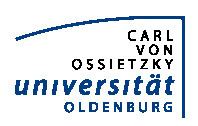Motto in English Open for new ways Established 1973 Administrative staff 964 (2014) Total enrollment 13,746 (2014) Academic staff 1,352 (2014) | Type Public President Hans Michael Piper Phone +49 441 7980 Founded 1973 | |
 | ||
Students 13,746 (winter semester 2014–2015) Address Ammerländer Heerstraße 114, 26129 Oldenburg, Germany Motto Offen für neue Wege (Open for new ways) Affiliation European University Association Notable alumni Jürgen Krogmann, Lars Rudolph, Claudia Kemfert Similar University of Osnabrück, University of Bremen, Leibniz University of Hanover, Leuphana University of Lüneb, Braunschweig University of Techno Profiles | ||
Microbiology at the university of oldenburg
The Carl von Ossietzky University of Oldenburg (German: Carl von Ossietzky Universität Oldenburg) is a university located in Oldenburg, Germany. It is one of the most important and highly regarded educational facilities in northwestern Germany and specialises in interdisciplinary & sustainable development studies and renewable energy studies with focus on solar and wind energy.
Contents
- Microbiology at the university of oldenburg
- Lipdub university of oldenburg 2012
- History
- University Profile
- Departments
- Cultural and political life
- Canteens
- International Partnerships
- Awards
- References
Lipdub university of oldenburg 2012
History
The first teachers training was held in Oldenburg as early as 1793, launched by Duke Peter Friedrich Ludwig. A garden seminar for teachers training was created in 1882. During the Weimar Republic, the establishment of the Pedagogical Academy (Pädagogische Akademie) in Oldenburg in 1929 enabled the vocational training of teachers. On 1 October 1945 the institution reopened in postwar Germany. In 1948 it was renamed the Pedagogical College Oldenburg (Pädagogische Hochschule Oldenburg).
The first step towards the university was done on 23 February 1959 with the decision of the city council to launch a university project, which was followed in 1970 with the Memorandum establishing the University of Oldenburg from the Minister of Culture of Lower Saxony. The university was finally founded in 1973. Enrollment and teaching started in the summer semester of 1974, with an education curriculum for 2,400 students. In 1991, the university was officially named after the resistance fighter and Nobel laureate Carl von Ossietzky, having been denied to take on his name by previous conservative state governments. That same year, the number of students passed the mark of 10,000. The eleven departments of the university were reorganized into five faculties in 2002. By the end of 2011, there were about 11,325 students.
In 2012, the university founded the faculty of medicine and health sciences, introducing a 12-semester course in human medicine, which leads students to the German state examination, Staatsexamen, a prerequisite to practice as a physician. The new faculty is part of the European Medical School Oldenburg-Groningen (EMS), a cooperation between the University of Oldenburg, the University of Groningen (Netherlands), and local hospitals.
University Profile
The university offers 95 courses of study. Due to the Bologna Process, in 2004 Oldenburg adopted Bachelor and Masters degrees in place of the former Diplom and Magister. One main focus of the university is the schooling of teachers, which was established during the 1970s and remains a strong profile, with master's degrees for teaching offered in all faculties. The PhD program Didactical reconstruction is especially renowned, as is the research in sustainable development, encompassing several academic disciplines. The university is also allowed to confer Doctorates and oversee Habilitations.
The campus is split into two locations, the major one being Uhlhornsweg, where the main library, the mensa and the administration along with most of the departments is housed. Having used the buildings of the former teaching college during the first years, the main buildings of the university were inaugurated in 1982, with ongoing extensions since then, including the main lecture hall in 2001. The Wechloy campus, also first opened in 1982, is home to the studies of natural sciences as well as the library of natural sciences.
As part of the Universities Excellence Initiative, the university was awarded a Cluster of Excellence for its initiative Hearing4all. The cluster deals with research into the improvement of speech understanding in background noise and has a funding of €34 million.
Departments
Cultural and political life
The Studentenwerk of the University organizes the cultural bureau UNICUM and the theatre since 1985. UNICUM includes theatrical groups from the university as well as freelancers. The group Gegenlicht runs a cinema in the Old Aula and on campus during the summer, while the programme zwergWERK is focused on the presentation of short films.
As in other German universities, the AStA is the most important organ of student representation. It administers the public transport tickets for the student body, offers several forms of student loans and organizes festivities. In addition, the AStA is continually involved in campaigns concerning university policy and social activism.
Canteens
The Studentenwerk Oldenburg operates canteens both the Uhlhornsweg and the Wechloy campus. These are certified by the BIO seal since January 2004. In the main cafeteria at Uhlhornsweg, four different dishes are available every day, as well as side dishes. In addition, different pasta is served daily, and a selection of high quality, self-composable, courts, at slightly higher prices, is available at the Culinarium.
In 2001, the cafeteria at Uhlhornsweg took first place in the taste category and ended up in second place overall at the German-wide canteen ranking done by UNICUM magazine. The following years, it steadily dropped, but in 2008, it managed to return to second place overall, and again become first ranked in the taste category.
In addition to the canteens, the Studentenwerk operates a large cafeteria on Uhlhornsweg campus. In Wechloy, canteen and cafeteria are combined in the same area.
International Partnerships
The first major cross-border cooperation was started in 1980 with the Rijksuniversiteit Groningen. It has since then resulted in an especially far-reaching partnership, with several majors jointly offered by the two universities.
The university participates in the ERASMUS programme, a partnership for student exchanges in Europe. It maintains cooperation agreements with 105 universities in 44 countries.
